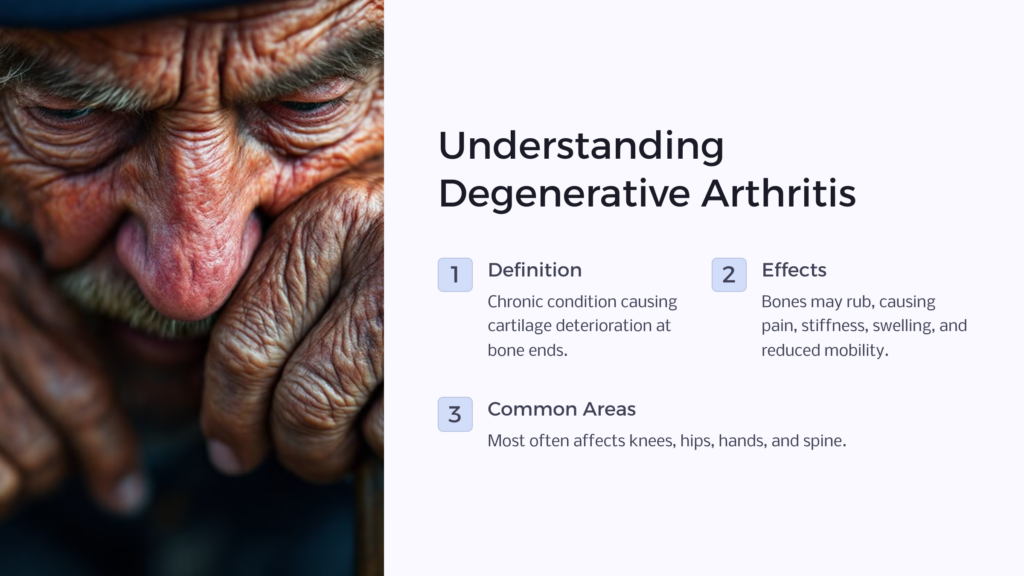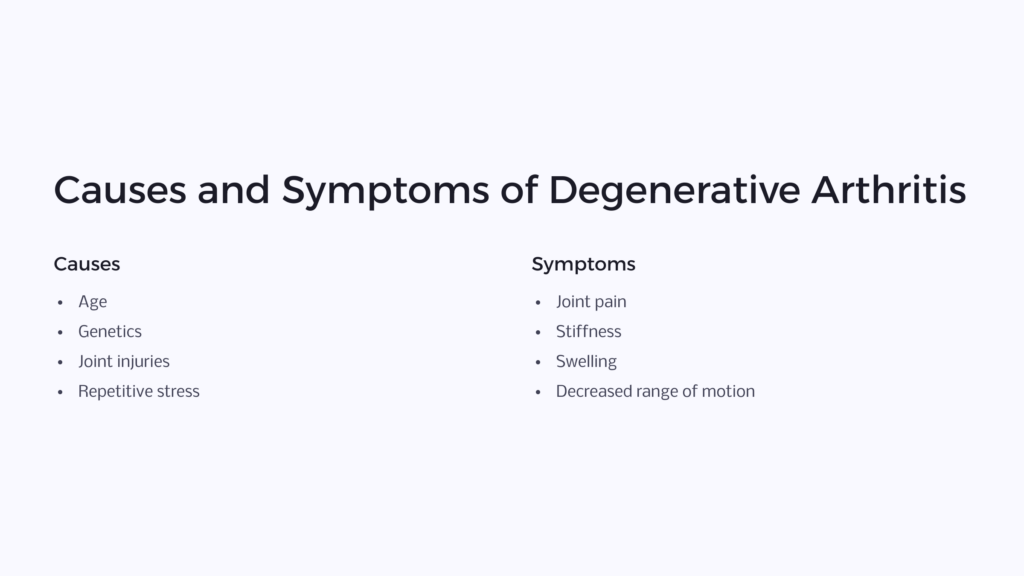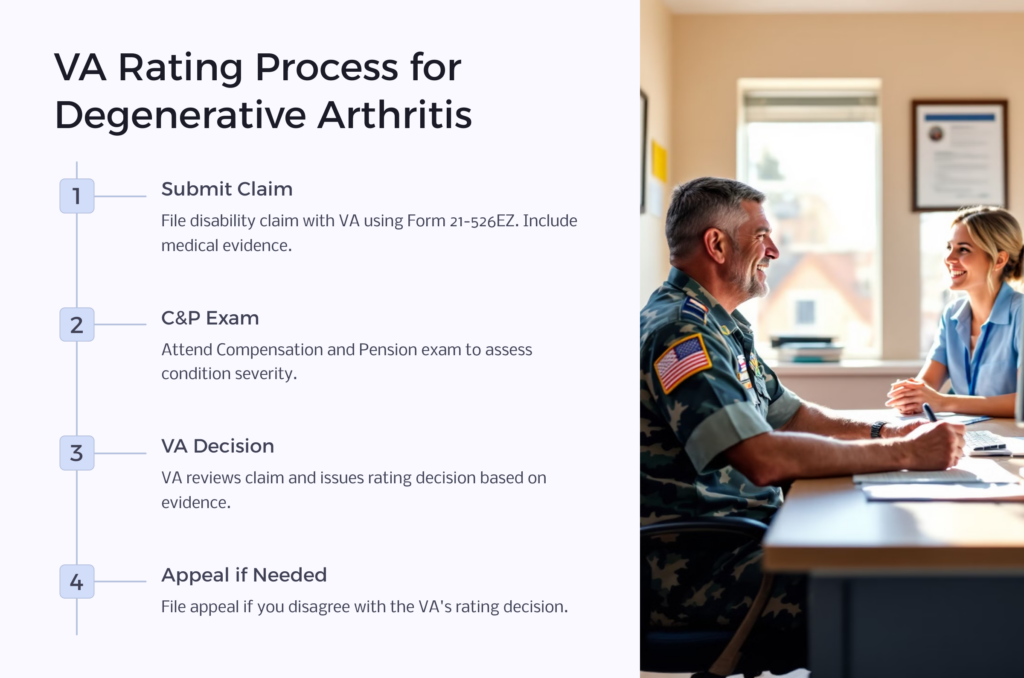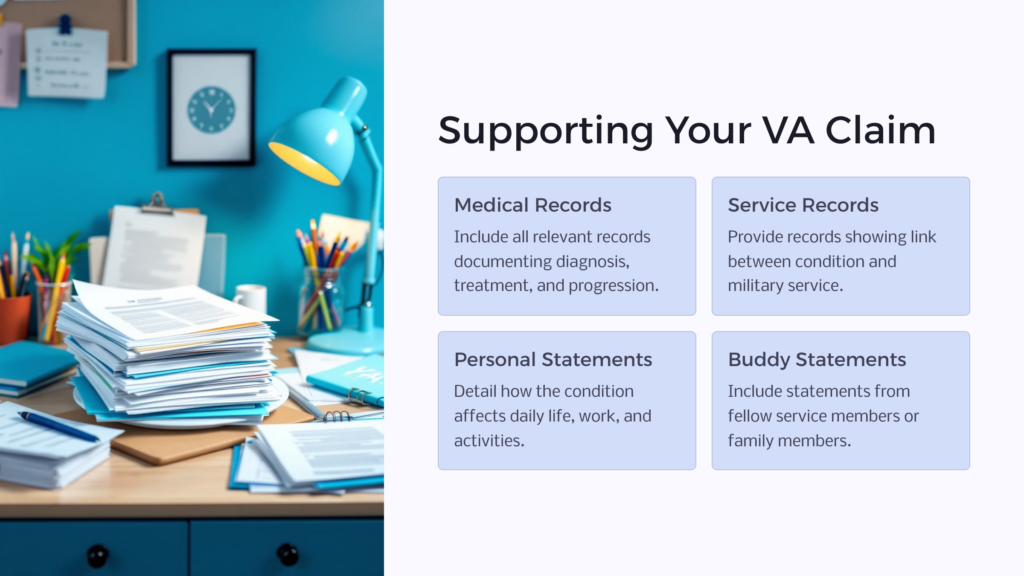Many Americans suffer from degenerative arthritis, commonly known as osteoarthritis. Due to the physical demands on their bodies, veterans are particularly susceptible to this often crippling disease. Through the US Department of Veterans Affairs (VA) these vets may be eligible for disability benefits due to this disease. The agency will assign a disability rating to each veteran based on the severity of the symptoms and the impact the disease has on their daily life.
A Brief Description of Degenerative Arthritis

Degenerative arthritis, or osteoarthritis, is a chronic condition characterized by the deterioration of cartilage—the flexible tissue at the ends of bones that facilitates smooth joint movement. As this cartilage gets worn down, bones may begin to rub against each other, leading to pain, stiffness, swelling, and decreased mobility. Over time, this can cause significant discomfort and impair daily activities. While osteoarthritis can affect any joint, it’s most commonly seen in the knees, hips, hands, and spine.
An Explanation of VA Disability Ratings
The VA disability rating system helps to evaluate the extent of a veteran’s disability and determine the corresponding compensation. Ratings are expressed in percentages. The higher the rate the greater the level of disability and, consequently, the higher the compensation. These ratings are based on the severity of symptoms, the impact on the veteran’s ability to work, and the overall effect on their quality of life.
Understanding how the VA rates conditions like degenerative arthritis is crucial for veterans seeking compensation for service-related disabilities.
Understanding Degenerative Arthritis
Degenerative arthritis is the most common form of arthritis and a leading cause of disability among adults, particularly as they get older. The disease is a progressive one that develops slowly over time. The condition primarily affects the joints, where cartilage breaks down. As the cartilage wears away, bones may grind against each other, leading to pain, inflammation, and reduced joint function.
Causes and Symptoms of Degenerative Arthritis

Several factors play a part in the development of degenerative arthritis, including age, genetics, joint injuries, and repetitive stress on the joints. When it comes to veterans, the physical demands of training, combat, and other activities can place significant strain on their joints, increasing the risk of developing osteoarthritis. Symptoms of OA include joint pain, stiffness (particularly after periods of inactivity), swelling, tenderness, and a decreased range of motion. They can vary in intensity. Some people will experience mild discomfort while others can suffer severe, debilitating pain.
Common Treatments and Interventions for Degenerative Arthritis
First and foremost, there is no cure for degenerative arthritis. However, there are treatments and interventions that can help patients manage their symptoms. Some of these include:
- Medications: Over-the-counter and prescription pain relievers, nonsteroidal anti-inflammatory drugs (NSAIDs), and corticosteroids can reduce pain and inflammation.
- Physical Therapy: Physical therapy and increased movement can help strengthen the muscles around the joints, improve flexibility, and reduce pain.
- Lifestyle Changes: Maintaining a healthy weight, engaging in low-impact exercises, and adopting ergonomic practices can alleviate stress on the joints.
- Surgical Interventions: In severe cases, surgical options such as joint replacement or arthroscopy may be considered to repair or replace damaged joints.
Understanding the VA Rating System
The VA rating system is an important part of the benefits process for veterans with service-connected disabilities. After considering all factors, the VA will assign a percentage rating to a veteran’s disability based on the severity of their condition and its impact on their ability to work and perform daily activities.
The ratings range from 0% to 100%, in increments of 10%, with higher percentages representing more severe disabilities–a rating of 100% equates to total disability. The rating system is governed by the VA’s Schedule for Rating Disabilities (VASRD), a comprehensive guide that outlines the criteria for evaluating various conditions.
Importance of the VA Rating System to Military Veterans
The VA rating system plays a vital role in determining a veteran’s eligibility for disability compensation and other benefits. A higher rating means an increased monthly compensation and also provides access to additional benefits like health care and housing assistance. It’s vital to understand the VA disability rating system to ensure veterans receive the maximum compensation they deserve for their service-related disabilities.
General Breakdown of How the VA Rating System Works
The VA rating process begins with the submission of a disability claim, accompanied by medical records and other evidence supporting the condition. The VA reviews the claim and assigns a rating based on the facts at hand. Ratings are determined using the VASRD, which provides detailed criteria for each condition.
For example, ratings for those with a degenerative arthritis diagnosis are based on the limitation of motion in the affected joints, pain, and the presence of deformities or other symptoms. Veterans may receive a single rating for a specific condition or multiple ratings for several conditions, which are then combined using the VA’s “whole person” approach to determine the overall disability rating.
The Link Between Degenerative Arthritis and Military Service
A fact of life is that military service is inherently physical. It often involves rigorous activities with repetitive movements including carrying heavy equipment and hiking, often while being exposed to harsh conditions and extreme temperatures. These activities can place significant strain on the joints, leading to wear and tear over time. For many veterans, the physical demands of their service contribute to the development of degenerative arthritis, particularly in weight-bearing joints such as the knees, hips, and spine.
Studies and Statistics on Incidence Rates of Degenerative Arthritis Among Veterans
Numerous studies have highlighted the increased prevalence of degenerative arthritis among veterans compared to the general population. According to the CDC, veterans are up to 60% more likely to develop osteoarthritis due to the physical demands of their service than non-veterans. The incidence rates are particularly high among veterans who served in combat roles, where the risk of joint injuries and repetitive stress is greater.
How the VA Rates Degenerative Arthritis
The VA assigns ratings for degenerative arthritis under the musculoskeletal system section of the VASRD. The rating is primarily based on the limited mobility in the affected joints, which is assessed during a Compensation and Pension (C&P) exam. The VA considers factors such as pain, swelling, and stiffness when determining the extent of the limitation.
Levels of Severity and Their Corresponding VA Rating Percentages
Degenerative arthritis is typically rated under Diagnostic Code 5003 in the VASRD. If the condition results in a minor limitation of motion, the VA may assign a rating between 10% and 20%. A 10% rating is generally awarded if the veteran experiences pain and limited motion in one or two major joints or minor joint groups. A 20% rating may be assigned if there is evidence of incapacitating episodes, such as periods of acute flare-ups that require bed rest or medical intervention. In cases where multiple joints are affected or the condition is severe, the VA may assign a higher combined rating based on the overall impact on the veteran’s health.
Description of the Evaluation Process and Criteria Used by the VA
The evaluation process for degenerative arthritis begins with the submission of a disability claim to the VA. The veteran must provide medical evidence, including a diagnosis of degenerative arthritis and documentation of symptoms. The VA will schedule a C&P exam, during which a medical professional assesses the veteran’s range of motion, pain levels, and any functional limitations. The findings are used to determine the severity of the condition and the appropriate rating. The VA also considers the veteran’s medical history, including any treatments or surgeries, when evaluating the claim.
Navigating the VA Claim Process for Degenerative Arthritis

When making a claim for any VA benefits, it’s important to understand the process and follow all the steps meticulously. This will give the veteran the best chance of approval with the most accurate rating.
Step-by-Step Guide to Filing a VA Claim for Degenerative Arthritis
- Gather Medical Evidence: Get all medical records from care professionals that document the diagnosis of degenerative arthritis and any related symptoms. These may include doctor’s notes, imaging studies (such as X-rays or MRIs), and treatment records.
- Submit a VA Disability Claim: File a disability claim with the VA using VA Form 21-526EZ, either online through the VA’s eBenefits portal or by mail. Ensure that the claim includes all relevant medical evidence and details on how the condition is related to military service.
- Attend the C&P Exam: After submitting the claim, the VA will schedule a C&P exam to assess the severity of the condition. Attend the exam and provide detailed information about your symptoms and how they affect your daily life. Failure to attend this exam can significantly impact chances of approval.
- Await the VA’s Decision: For many, this is the hardest part of the process. The VA will review the claim, including the C&P exam results, and issue a rating decision. This process can take several months, depending on the complexity of the claim and the VA’s current workload.
- Appeal if Necessary: If you disagree with the VA’s rating decision, you can file an appeal. This involves submitting a Notice of Disagreement (NOD) and providing additional evidence to support your claim.
Necessary Documentation and Evidence to Support a Claim

To support a disability claim for degenerative arthritis, you should provide the following documentation:
- Medical Records: These should include all relevant medical records that document the diagnosis, treatment, and progression of degenerative arthritis.
- Service Records: Provide service records that demonstrate a link between the condition and military service. For example, records of joint injuries or physically demanding duties.
- Personal Statements: Submit statements detailing how the condition affects your daily life, including work, hobbies, and daily activities.
- Buddy Statements: Consider including statements from fellow service members or family members who can attest to the impact of the condition.
Tips and Common Pitfalls to Avoid During the Claim Process
- Be Thorough: Make sure that all relevant medical evidence is included in your claim. Incomplete or insufficient evidence is a common reason for claim denials.
- Attend All Appointments: Attend the C&P exam and any other appointments scheduled by the VA. Missing an appointment can delay the claim process and result in a lower rating.
- Be Honest and Detailed: Provide accurate and detailed information about your symptoms during the C&P exam. Exaggerating or downplaying symptoms can lead to an inaccurate rating. Deliberate falsehoods can be deemed fraudulent and lead to criminal punishments.
- Seek Assistance: The claims process can be confusing to many. To help navigate the system, consider seeking help from a Veterans Service Officer (VSO) or an accredited representative or lawyer to guide you through the system.
The Importance of Seeking Medical and Legal Assistance for VA Claims
Getting professional medical advice is vital for veterans making a disability claim. This is especially true for degenerative arthritis claims. A thorough medical evaluation ensures an accurate diagnosis and helps document the severity of the condition, which is essential for a successful VA claim. Additionally, a qualified healthcare provider can recommend appropriate treatments to manage symptoms and improve quality of life.
Navigating the VA claim process can be complex, and many veterans may benefit from legal representation to ensure their claim is properly handled. An experienced attorney or accredited representative can help gather evidence, complete paperwork, and advocate on the veteran’s behalf. Legal representation is particularly valuable if the claim is denied or if an appeal is necessary.
Many types of organizations offer assistance to veterans filing VA claims, including:
- Veterans Service Organizations (VSOs): Groups such as the American Legion, Veterans of Foreign Wars (VFW), and Disabled American Veterans (DAV) often provide free assistance to those navigating the VA disabilities claim process.
- Accredited Representatives: Accredited representatives, including attorneys and claims agents, are approved by the VA to assist veterans with their claims.
- VA Resources: The VA offers various resources, including the eBenefits portal, where veterans can file claims and track their status.
Conclusion
Degenerative arthritis, also known as osteoarthritis or OA, is a common medical condition among veterans, particularly those who have engaged in physically demanding activities during their time in the service. The VA rating system provides a means to evaluate a veteran’s condition, which helps to determine compensation for service-related disabilities, including degenerative arthritis. Understanding the VA’s evaluation process, gathering the necessary documentation, and seeking professional assistance can significantly improve the chances of a successful claim.
Veterans experiencing symptoms of degenerative arthritis should not hesitate to seek medical attention and explore their options for VA compensation. As the VA system continues to evolve, veterans need to stay informed about updates to the rating criteria and available treatments for degenerative arthritis. Check out Benefits.com for the latest, up-to-date information.
 Benefits.com Advisors
Benefits.com Advisors
With expertise spanning local, state, and federal benefit programs, our team is dedicated to guiding individuals towards the perfect program tailored to their unique circumstances.
Rise to the top with Peak Benefits!
Join our Peak Benefits Newsletter for the latest news, resources, and offers on all things government benefits.



















